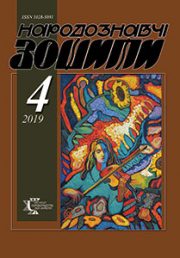The Ethnology Notebooks. 2022. № 2 (164), 491—500
UDK 930.2:73.01.03.071.1.072.2 (477)”18/19″
DOI https://doi.org/10.15407/nz2022.02.491
VASYL MASYUTYN AND HIS CREATIVE RECONSTRUCTIONS NATIONAL HISTORY
YATSIV Roman
- ORCID ID: https://orcid.org/0000-0003-1509-5367
- Doctor of Historical Sciences, Professor,
- Lviv National Academy of Arts,
- Art Wood Department,
- 38, V. Kubiyovycha Str., 79011, Lviv, Ukraine,
- Contacts: e-mail: jaciv@ukr.net
Abstract. The article considers a large array of sculptural works of the outstanding Ukrainian artist and writer, art theorist Vasyl Masyutin (1884—1955). The author called the series of medals dedicated to figures of Ukrainian history and culture «medal monographs», seeing in the very idea of his initiative an important mission of consolidating national consciousness. The artist’s approaches to the problem of visualization of images of key figures of the princely, Cossack era and national-cultural rise and state processes of the XIX — early XX centuries are valuable, partly described by him in the accompanying texts.
The relevance of the article is that for the first time in historical science the historiography of the relevant aspect of V. Masyutin’s creative heritage is studied in detail, an attempt is made to scientifically qualify the artist’s creative and reconstructive method in the general strategy of his historiosophical research and national self-identification.
The object of research is part of the rich artistic work of V. Masyutin — works of medal sculpture, the subject — a set of approaches of the author to the solution of artistic images of prominent figures of Ukrainian history and culture.
The methodological basis of the study is biographical, historical-comparative and scientific-interpretative methods, involving ethnopsychological approach to the disclosure of the factor of the author’s subconscious in the overall evolution of his return to Ukrainian cultural and genetic roots.
Keywords: History of Ukraine, historiosophy, sculpture, medal making, portrait genre, creative reconstruction of images of historical personalities, etching, woodcut, national self-identification, plastic-image thinking, grotesque, stylistics.
Received 1.06.2022
REFERENCES
- Galeev, I. (2012). Masyutin / Masyutin. 1884/1955. Vasily Nikolaevich Masyutin. 1884—1955. Engraving, drawing, painting (P. 6—17). Moscow: Galeev Gallery [in Russian].
- (2012). Chronicle of the life of V. Masyutin. Vasily Nikolaevich Masyutin. 1884—1955. Engraving, drawing, painting (P. 18—21). Moscow: Galeev Gallery [in Russian].
- Masyutyn, V. (1935, april 28). Our hetmans. Novy Chas. Lviv [in Ukrainian].
- Masyutyn, V. (1937, march 2). Medal images of Ukrainian national heroes. Svoboda (Part 49). Jersey City; N. J. [in Ukrainian].
- Hordynsky, S. (1963, july 24). Artistic heritage of Vasyl Masyutyn. Svoboda (Part 138). Jersey City; N. J. [in Ukrainian].
- M., H. [Mykola, Holubets]. (1935, march 23). Vasyl Masyutyn (On the eve of the arrival of the great artist in Lviv). Novy Chas. Lviv [in Ukrainian].
- Werner, X. (1989). Wassili Masjutin in Riga, Moskau und Berlin: Sein Leben in Bildern und Dokumenten. Berlin [in German].
- Ttt., Sch. (1936). Wasilijef Masjutin. Gebrauchsgraphik (Bd. 11, pp. 43—49). Berlin [in German].
- Plato, M. (1928). Wassilij Masjutin. Gebrauchsgraphik (Bd. 10, pp. 41—53). Berlin [in German].
- Kovzhun, P. (1934, february 15).Vasyl Masyutyn. Nazustrich (Part 4, p. 1). Lviv [in Ukrainian].
- Kovzhun, P. (1935, may, 2). Vasyl Masyutyn. Dilo (Part 112). Lviv [in Ukrainian].
- Dragan, M. (1934, november 15). Historical portraits. Nazustrich (Part 18, p. 1). Lviv [in Ukrainian].
- Lasovsky, V. (1935, april, 15). Universalist on a soft sofa: an unfinished interview with V. Masyutyn. Nazustrich (Part 8, pp. 1—2). Lviv [in Ukrainian].
- Hordynsky, S. (1956, january 12). Vasyl Masyutyn. Svoboda (Pary 6). Jersey City; N. J. [in Ukrainian].
- Hordynsky, S. (1956, february). Between fiction, history and reality (the work of Vasyl Masyutyn). Ukrainska Literaturna Gazeta (Part 2, p. 3). Munich [in Ukrainian].
- Bilokin, S. (1992, may-june). Vasyl Masyutyn. Obrazotvorche Mystetstvo (Part 3, pp. 38—40). Kyiv [in Ukrainian].
- Masyutyn, V., & Vynnychuk, Ju. (Ed.). (2019). Princess Nefreta: story. Kharkiv: Folio [in Ukrainian].
- Gollerbach, E. (2012). Graphics by V.N. Masyutin. Vasily Nikolaevich Masyutin. 1884—1955. Engraving, drawing, painting (Pp. 40—54). Moscow: Galeev Gallery [in Russian].
- Holian, R. (1934, december 15). From the impressions of a migratory bird. Nazustrich (Part 24, p. 3). Lviv [in Ukrainian].
- Masjutin, W. (1939). Pawlo Kowzun. Gebrauchsgraphik (Bd. 9, pp. 17—20). Berlin [in German].
- (2012). Letters of V.N. Masyutin from the special camp № 3 NKVD Hohenschonhausen, Berlin. Vasily Nikolaevich Masyutin. 1884—1955. Engraving, drawing, painting (P. 250—251). Moscow: Galeev Gallery [in Russian].
- Yarova, G., Pavlyshyn, M., & Zhuravlev, V. (Eds.).(2015). History of Ukraine in commemorative medals of Vasyl Masyutyn: Catalog of the exhibition. Kyiv: Art-Insight Gallery; Museum of the Hetmanate [in Ukrainian].
- Masyutyn, V. (1935, may 1). Eye, heart and brush. Zhinka (P. 4). Lviv [in Ukrainian].







